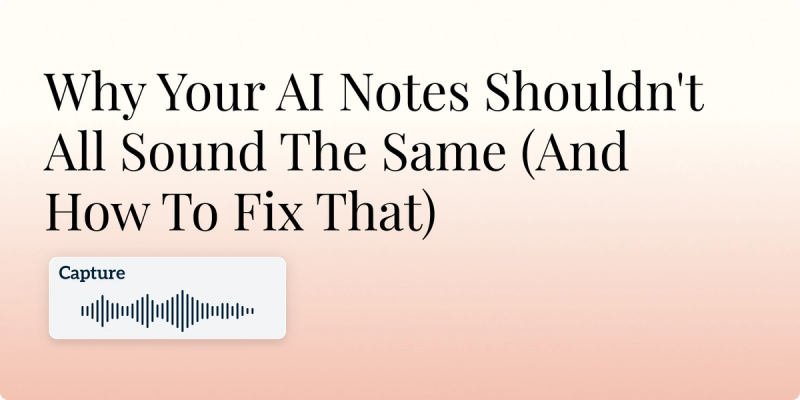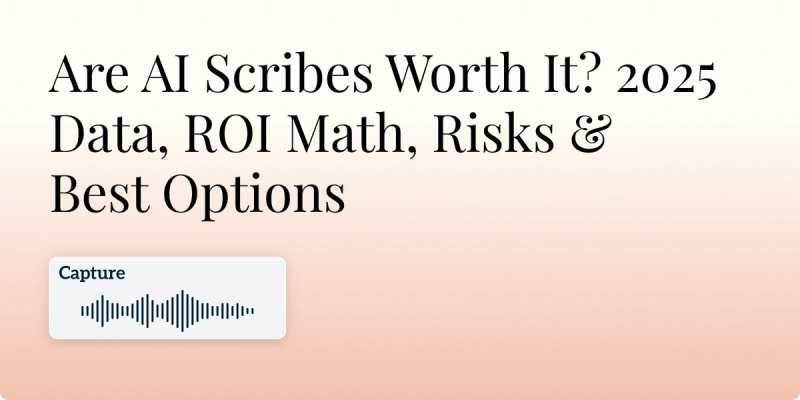
Why Your AI Notes Shouldn't All Sound The Same (And How To Fix That)

If you've ever reviewed a series of AI therapy notes and felt an unsettling sense of Déjà vu, you've encountered the “clone effect,” where distinct patient stories are flattened into identical/robotic templates. This isn't just a stylistic annoyance; it's a failure in clinical documentation. When every note for ‘generalized anxiety’ reads the same, the unique human context behind each diagnosis is erased, undermining your clinical judgment.
The culprit is rarely the AI itself, but how we command it. A generic prompt begets a generic note. The solution lies in moving from passive user to active director, employing strategic prompting techniques that force the AI to capture nuance, individual language, and specific clinical observations that define quality care.
This guide will provide the technical framework to transform your AI therapy scribe into a nuanced clinical partner, ensuring your documentation is as unique as the patients you treat.
Why “Cookie-Cutter” Notes Are a Clinical Problem
Efficient documentation should never come at the cost of clinical integrity. When AI therapy notes become formulaic, they introduce significant risks that undermine the very purpose of patient records.
The Illusion of Objectivity
Generic notes create a false sense of uniform patient presentation, masking the unique factors that drive diagnosis and treatment planning. By stripping away individual context, they can mislead clinicians into seeing patterns that dont exist while overlooking crucial nuances.
Example:
- Generic Note: “Patient reports low mood and anhedonia.”
- Specific Note: “Patient describes their mood as ‘a heavy gray blanket’ noting a specific loss of joy from gardening, which was their primary coping mechanism for 15 years.”
The specific version doesn't just state symptoms; it provides clinically actionable information about the severity (metaphor), specific activities impacted (such as gardening), and the functional significance (long‑term coping mechanism).
Erosion of Clinical Reasoning
Repetitive documentation creates a feedback loop that breeds cognitive complacency. When notes consistently lack distinguishing features, clinicians may unconsciously skim familiar content, potentially missing subtle shifts in a patient's status across visits. This documentation pattern can gradually dull the analytical precision required for effective differential diagnosis.
Compromised Continuity of Care
SOAP notes serve as communication tools between providers. Vague documentation fails to provide the necessary context for other clinicians who may treat the patient, potentially leading to disjointed or inappropriate care.
Example:
- Poor Context: “Patient avoids social situations.”
- Actionable Context: “Patient declines party invitations but maintains attendance at their weekly book club, stating ‘I can handle small groups where I know the topic’”
The detailed version gives future providers crucial information about current functioning, specific triggers, preserved capabilities, enabling them to build effectively on existing treatment rather than starting from scratch.
Why AI Defaults to Generic Language
Understanding why AI produces generic text is the first step toward fixing it. The issue isn't a lack of intelligence, but the inherent nature of how these models are built and used.
The Average Training Data
AI models are trained on millions of clinical notes and texts. Their primary function is to predict the most statistically likely word or phrase to follow another. Consequently, their default output is a compilation of a safe, averaged representation of how thousands of notes for ‘major depressive disorder’ or ‘generalized anxiety’ typically sound. It defaults to the common denominator, stripping away the outliers and specifics that make a case unique.
The Safety of Generality
For an AI, vague language is a low‑risk strategy. Stating “patient reported sleep disturbances” is almost always technically correct and avoids the peril of “hallucination”, where AI might invent an incorrect, specific detail like ‘patient slept 5 hours’ when they actually slept around 8. Generality is the AI’s path of least resistance and lowest factual error.
The Prompting Gap
The core issue is often a failure of instruction, not technology. An AI is an engine waiting for a map. A vague, low‑effort prompt like ‘write a therapy note’ provides no direction for highly specific therapy note personalization.
A Framework for Clinically Individualized Notes
Transforming your AI therapy notes from generic to clinically sound requires a shift in how you issue commands. Think of it as moving from giving an address to providing turn‑by‑turn navigation.
The Structured Prompt
Treat your instruction as a structured clinical command that specifies the what, how, and why.
- Concept: A structured prompt provides context, specific details, and a clear directive. Preventing the AI from filling in the blanks with generic fluff.
Example:
- Bad Prompt: “Write a therapy note for a patient with PTSD.”
- Good Prompt: “Draft a therapy SOAP note for a patient with PTSD. In the Subjective, focus on their description of hypervigilance. Use their direct quote: ‘I feel like I'm always scanning a room for the nearest exit’. Specify that the trigger today was a crowded supermarket and the coping skill we practiced was the 5-4-3-2-1 grounding technique.”
Inject Clinical Nuance
Command the AI to incorporate the patient's own language and your specific behavioural observations to create a vivid clinical picture.
- Concept: Make the AI ‘show’ the clinical reality through direct quotes and observed behaviors instead of ‘telling’ with broad, canned diagnoses.
Example:
- Telling (Generic): “The patient has interpersonal difficulties.”
- Showing (Specific): “Incorporate the patient's quote about work: ‘I feel like I have to perform a character to be liked.’ Also, document the observed shift in their body language when discussing their manager: they crossed their arms and broke eye contact for the remainder of the session.”
Controlling Tone and Focus
Explicitly tell the AI the central theme or clinical priority of the session to shape the entire note’s emphasis and structure.
- Concept: Guide the AI to frame the note around a specific clinical narrative, such as progress, risk, or a specific therapeutic skill.
Example:
- Prompt for a Progress-Focused Note: “Highlight the patient’s reported improvement in using cognitive reframing. Frame the entire note around their success in challenging the automatic thought ‘I am a failure’ after they received positive feedback from their manager.”
- Prompt for a Risk Assessment Note: “ Structure this note to emphasize assessment of elevated suicide risk. In the Assessment and Plan, detail the disclosed plan (medication), rate the ideation intensity as 6/10, and list the identified protective factors: a strong bond with cat and a scheduled follow-up in 48 hours.
Leveraging Your AI Scribes' Advanced Features
Moving beyond basic prompting allows you to bake specificity directly into your workflow. The most advanced use of therapy note personalization involves configuring it to align with your clinical thinking patterns.
Custom Templates and Macros
Instead of crafting a new, detailed prompt for every intake or crisis session, you can build and save custom templates for your most frequent scenarios.
- How it Works: You create a detailed prompt for a specific type of visit. This template includes all structural commands and placeholders for patient-specific details you would normally type manually.
- Example: A ‘first-session intake’ macro could be programmed with: “Generate a comprehensive intake note. Structure the HPI using OLDCARTS. Include a detailed psychosocial assessment. Prompt me for the patient's specific chief complaint and their stated goals for therapy.”
- Benefit: This saves cognitive energy and ensures consistency, allowing you to generate a structured draft with a single click, which you personalize.
The Power of Post-Processing
The draft is the starting point, not the final product. The clinicians' irreplaceable expertise is applied in the final edit.
- Concept: Your role shifts from writer to editor. You review the draft for accuracy, add a crucial point the AI might have missed, refine a phrase for better clinical precision, and ensure the Assessment reflects your nuanced judgment.
- Seamless Workflow: In tools designed for this, like specialized AI therapy notes tools, this process is intuitive. The draft is presented in an easy-to-edit format within your EHR, making the transition from AI-generated foundation to clinician-perfected note very efficient.
Conclusion
The journey toward better documentation is not about working against your AI therapy scribe, but about learning to command it effectively. As we've seen, unique notes are not a mere stylistic preference; they are a cornerstone of quality care, essential for accurate clinical reasoning, seamless care coordination, and a legally defensible record. The power to create them lies squarely in how you guide the AI. By moving from a passive to an active user, you fundamentally transform the technology's role.
This approach allows you to reclaim the narrative of your clinical work. You elevate your AI scribe from a simple transcriptionist into a true clinical partner, ensuring that the story captured in the chart is as complex, human, and individualized as the patient in the room.
Frequently Asked Questions
ABOUT THE AUTHOR
Dr. Eli Neimark
Licensed Medical Doctor
Reduce burnout,
improve patient care.
Join thousands of clinicians already using AI to become more efficient.

How To Keep Your Notes Personal–Even When Using AI
Using an AI scribe doesn't mean generic notes. Learn practical strategies to ensure your notes retain your unique clinical voice and style.

Are AI Scribes Worth It? 2025 Data, ROI Math, Risks & Best Options
Are AI scribes worth it in 2025? See peer‑reviewed results, real costs, HIPAA & risk checks, and a simple ROI calculator - plus who should (and shouldn’t) buy.

Best AI Scribe Tools in 2026: Features, Benefits and Pricing
Discover the best AI scribe tools of 2026, including key features, benefits, and pricing, to simplify clinical documentation and enhance patient encounters.

